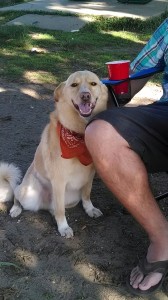I would make an awful cocaine addict. I’m non-committal, I’m barely scraping by on a student budget, and while the weight-loss would be nice, it would take a lot of coke to entertain the vast mucosa of my beak. Given that a few cups of coffee can launch me into a full-blown panic attack, stimulants are not my jam. As I leaned over my kitchen table this morning cutting a pile of white powder into equal lines with a razor blade, a summer gust of wind blew through the screen door and my beard and mustache were quickly dusted white. Odie gleefully wagged his tail and danced around in excitement, waiting impatiently for his daily hit, as I wiped the Piroxicam from my face.
Piroxicam is a human non-steroidal anti-inflammatory similar to ibuprofen and is given to dogs for a number of conditions. The human dose is too large for Odie’s weight, so I have to divide a capsule into multiple doses. In Odie’s case, his blight is terminal prostate cancer.
A few months ago, Odie presented with blood in his urine. Having a history of urinary tract infections, he was quickly treated with antibiotics and the symptoms resolved. But a few weeks later, he began to strain while watering my newly planted backyard. The vet found an enlarged prostate on manual exam, and much to both Odie’s and my own surprise, the vet handed me a latex glove and some lube and “showed” me his findings, as Odie and I took our relationship to a new level. Ultrasound confirmed calcification of the prostate, highly suggestive of cancer. Fortunately, further imaging showed no evidence of metastases anywhere in his body.
I’ve scoured journal articles on prostate cancer in dogs, consulted with a few vets, and even chatted with a veterinary oncologist. Treatment options are very limited, as radiation is ineffective and chemotherapy is unlikely to work. The end conclusion is the same: Odie’s clock is ticking, as most dogs live an average of three to six months after diagnosis. Given an early diagnosis, he could potentially make it another year.
I haven’t told Odie yet. In fact, I don’t think I have to tell him. Over the past few months, Odie has become much more cuddly and affectionate, less anxious, and better behaved. He goes on a lot more walks, joins us on outings to the park and snags burgers at picnics, and now sits proudly in the front seat on car rides. He lives for attention and spends every waking moment by our sides. He is more excited to see us walk through the door now than ever before. He knows something is up.
From the moment I met Odie, I had a gut feeling that he would be difficult. But I also knew I couldn’t leave him in an abusive home. When he rolled over to let me rub his belly, I knew he trusted me instantly. Along our journey, many people have criticized me for not euthanizing Odie or giving him to a shelter. Why waste my time and money on a problem? After all, “it’s just a dog.”
It is bittersweet that after years of unrest, behavior and aggression issues, abuse, a previous bout of cancer, infections, Lyme disease, and now a terminal illness, Odie has finally become what I’ve always hoped for: happy, less anxious, and content. I truly appreciate the support, both financial and emotional, from friends and family who have been champions for rehabilitating him to a better life.
Whether his time is measured in weeks or years, it is hard to dispute that Odie is enjoying the best moments of his life. My appreciation of him parallels my pride in him and at this point, his happiness is my own. In the meantime, we’ll keep doing lines of Piroxicam for breakfast and hope for the best. Odie may be just a dog. But he’s a damn good dog.


